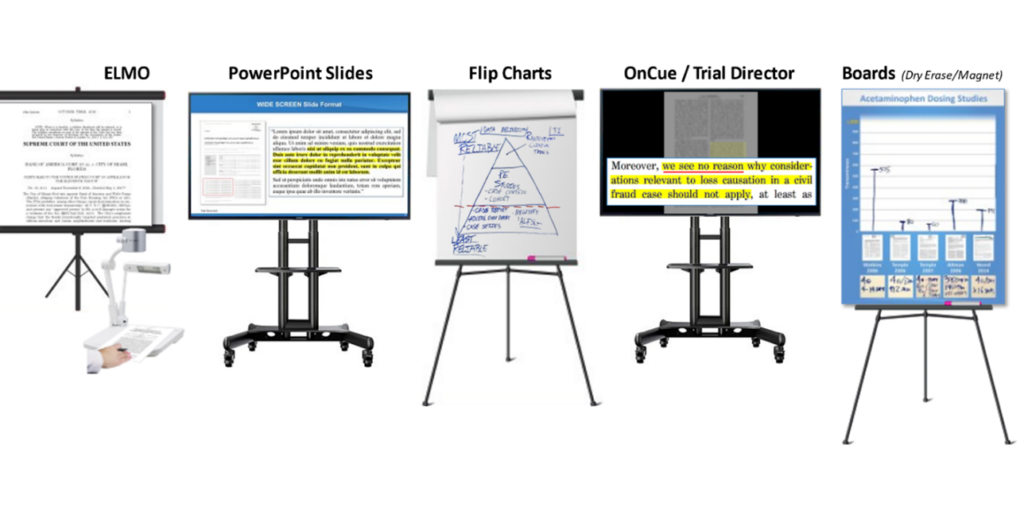Digital trial presentations make it easier to organize and display evidence.
Digital trial presentations make it easier to organize and display evidence.
Blog Article
How Trial Presentations Enhance Your Disagreement and Encourage Jurors
Test presentations function as a critical system for enhancing lawful arguments and encouraging jurors. By incorporating aesthetic aids, narrative frameworks, and psychological engagement, lawyers can develop a compelling situation that reverberates on numerous degrees. The strategic use visuals not only clears up complex details but additionally captures jurors' interest more effectively than words alone. The art of narration plays a just as essential function in changing factual evidence into a compelling narrative, shaping jurors' understandings. Comprehending these elements can significantly influence trial outcomes, elevating the concern of just how each component adds to this elaborate dynamic.

Importance of Aesthetic Help
Visual help play an important function in improving the effectiveness of test presentations, as they can considerably raise target market engagement and retention of details. In the context of a test, where jurors are charged with processing facility information, aesthetic aids serve to simplify and clarify bottom lines. Charts, charts, and pictures can share information and ideas that might otherwise overwhelm or confuse jurors, enabling for a more straightforward understanding of the proof offered.
Furthermore, visual aids aid in maintaining juror attention throughout the procedures. By breaking the uniformity of verbal testament, these devices can punctuate important disagreements, making them much more unforgettable. Reliable visual help can likewise evoke psychological actions, which can be essential in convincing jurors to line up with the presenter's story.

Crafting Engaging Stories
A compelling story is crucial in trial presentations, as it functions as the foundation of efficient persuasion. It permits lawyers to weave with each other facts, proof, and emotional elements into a systematic tale that reverberates with jurors. This narrative structure allows jurors to understand the complexities of the case while guiding them with the attorney's argument.
To craft a compelling story, lawyers must concentrate on clarity and comprehensibility. This entails establishing a clear lead character-- commonly the client-- and describing their journey via the events in question. Offering the truths in a rational series enhances understanding and preserves engagement. In addition, using vivid descriptions can create mental images that help jurors visualize the occasions, making the check my source narrative extra memorable.
Furthermore, incorporating essential motifs throughout the discussion reinforces the core message and help in retention - trial presentations. The narrative needs to not only convey info yet also stimulate a feeling of justice, highlighting the stakes entailed. Inevitably, a well-constructed story promotes a connection in between the jurors and the situation, positioning the attorney's disagreement as both credible and compelling, thereby boosting the probability of a positive judgment

Involving the Jury Mentally
Effective court involvement hinges on the attorney's capability to link with jurors on an emotional level. This link can significantly affect jurors' perceptions and their best decision-making. Utilizing sob stories permits lawyers to humanize the situation, transforming abstract legal ideas into relatable experiences. By offering real-life tales or reviews, lawyers can stimulate compassion and compassion, cultivating a much deeper understanding of the concerns at stake.
Aesthetic aids, such as pictures or videos, can better boost emotional interaction, providing jurors with vivid depictions of the case's human aspects. Crafting a story that highlights the battles and accomplishments of the people entailed ensures that jurors see beyond the lawful arguments and recognize the human repercussions of their choices.
Moreover, tone and body language next page play an essential role in communicating emotion. An attorney's passionate delivery can reverberate with jurors, reinforcing their psychological financial investment in the instance. It's vital to stabilize sob stories with accurate evidence, guaranteeing that jurors really feel obliged to act while remaining based in the reality. Eventually, an emotionally engaged jury is a lot more most likely to be convinced, making emotional link an important component of efficient test discussions.
Structuring Your Discussion

The body of the discussion must be logically segmented right into key factors, each sustained by compelling evidence. It is helpful to utilize narration methods to weave facts into a narrative that jurors can quickly follow. Visual help, such as graphes and videos, can enhance understanding and engagement, aiding to highlight important items of evidence.
Real-World Situation Researches
Checking out real-world case reference research studies offers very useful understandings into the art of test presentations and persuasion. The defense group effectively used a method that incorporated high-profile specialist statements with multimedia discussions, which mesmerized jurors and ultimately affected their choice.
One more significant instance is the "McDonald's Coffee Instance," where the plaintiff's attorneys made use of graphic photos of the injuries received by Stella Liebeck. trial presentations. This raw visual proof played a crucial role in communicating the intensity of her burns, leading to a significant jury award. Such situations show that impactful test presentations frequently rest on the reliable assimilation of visuals and storytelling to evoke psychological actions from jurors
In addition, the "Casey Anthony Test" highlighted the significance of narrative comprehensibility and credibility. The prosecution's failing to develop a compelling timeline diminished their influential power, emphasizing the necessity of a well-structured presentation. Examining these situations exposes that successful test discussions need tactical planning, psychological involvement, and the ability to reverberate with jurors' worths and ideas.
Final Thought
Trial presentations significantly enhance arguments and persuade jurors through the tactical use of aesthetic help, engaging stories, and emotional involvement. A well-structured discussion balances emotional charms with factual proof, ultimately resonating with jurors' worths.
Report this page